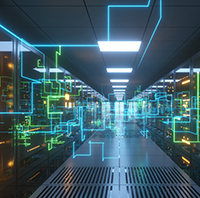The Future Landscape of Urban Data Centers
By: Craig Huffman

Digital infrastructure developers are setting their sights on big cities across the U.S. for the next generation of data center deployments. These urban locations serve as critical destinations for new builds, specifically designed to meet the growing demands for digital enablement of new and evolving technologies. With the ability to provide capacity for computational power, content hosting with proximity to end-users, and direct access to diverse fiber routes for high-bandwidth/low-latency data exchange, urban environments are a re-emerging focal point for data center development.
This apparent shift in locational preferences is in direct response to unprecedented demand for advanced digital architectural solutions across almost every vertical. According to a recent report published by Custom Market Insights, the digital infrastructure market is expected to grow by more than 57 percent in 2023 alone, reaching an anticipated value of $224 billion by year-end. Even more impressively, this market sizing estimate is expected to surpass $1 trillion by 2032. With the pervasive adoption of AI and other cloud-based technologies as a new “norm” for organizations of all sizes, it’s not difficult to see why demand is skyrocketing. These new technologies are predicted to become essential to the powering of business operations and are rapidly evolving in ways that are disrupting the status quo of digital infrastructure. As a result, the industry is forced to meet this growing demand head-on with solutions at a more foundational level of digital infrastructure, and that begins with re-imagining data centers themselves.
The Urban Shift
When you embark on the planning of a data center deployment, the conventional approach has been to design a sprawling facility in a rural or suburban setting—and there’s a reason for that. Hyperscalers traditionally built out “zones” with the necessary fiber connectivity and power supply enabling cloud-based solutions. In these areas, larger and more affordable plots of land could be purchased and built out with this necessary infrastructure, allowing developers to then build widespread, horizontally designed, data center facilities. However, the data hosting market is now facing a major shift.
The advent of widespread AI adoption has ushered in an entirely new set of requirements for data and application hosting and AI technology. In particular, the requirements are far more agnostic than the aforementioned “zone” architecture that factored into traditional business cases. More akin to edge data center deployments, latency has become a top priority, making proximity to end-users more critical than ever. Organizations with on-premises facilities are seeking a solution that allows them to keep their data local, and giant hyperscale cloud providers hundreds of miles away simply cannot meet that emerging requirement.
While the expansion of AI is impacting nearly every modern industry, the healthcare and biotech industries can serve as particularly compelling use cases for this emerging data center requirement, as these industries are experiencing some of the most profound disruptions. The COVID-19 pandemic resulted in a new set of technological demands within the medical community. It created a need for secure data sharing across networks that adhered to high standards of privacy protections in the facilitation of advanced telemedicine services. Furthermore, there has been a substantial influx of investments in medical research facilities and biotech incubators, primarily in urban zones (close to universities, for example), specifically focused on the development and production of vaccines and treatments. This rapid expansion has created new opportunities for growth within these healthcare-related industries. Consequently, there is now an immediate requirement for AI applications that enable the operational functions necessary to support the anticipated advancements in these medical fields.
The technologies used to drive biotech research and development rely on powerful processors and specialized hardware accelerators for their computer processing. To sustain the increased computational power required by AI, reliable and efficient access to power is crucial. Data center facilities need to be equipped to transfer data in petabytes to parallel neural-net processors, enabling near real-time responsiveness. As AI technology continues to evolve, the demand for computational power, data storage, and energy consumption will dramatically increase. To remain relevant, facilities must have scalable infrastructure components to support these changing requirements. What’s more, customers want to enable all this growth and evolution while hosting their data and applications in close proximity — within urban environments.
When it comes to network connectivity and power, densely populated urban environments offer the most developed infrastructure and receive the highest marks. This isn’t news. But even with all the megawatts, cable landings, and network infrastructure available in the world, we need to find a way to rethink the traditional architectural design that can function at the level of sprawling data center campuses, meeting the rising demands of customers in a much smaller space. As a result, there is a need and demand to re-imagine data center architecture entirely.
Think Vertical
Urban environments typically have a perceived abundance of power and connectivity along with proximity to end-users. The availability of fiber networks and power is relatively ubiquitous. However, urban data centers are usually subject to more restrictive land use, leaving little room to build horizontally. So how do we leverage these more attractive locations from an infrastructure and proximity standpoint in the building of new data centers? The answer lies within innovative vertical architectural



















